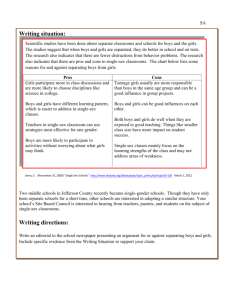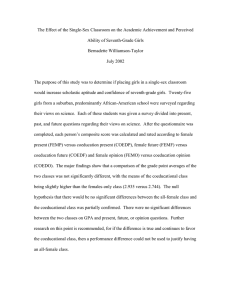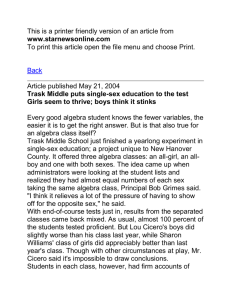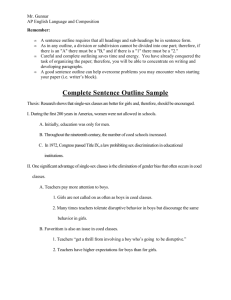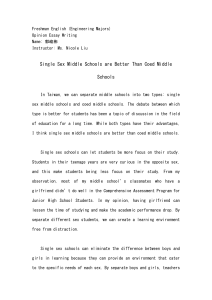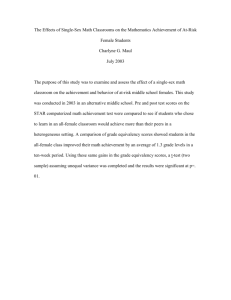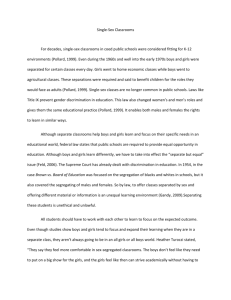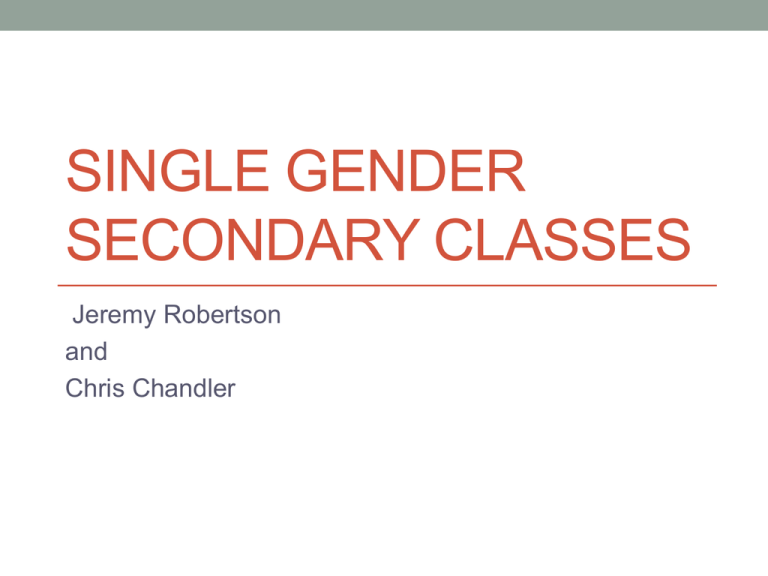
SINGLE GENDER
SECONDARY CLASSES
Jeremy Robertson
and
Chris Chandler
“There should not be any obstacle to providing single-sex
choice within the public school system...We have to look at
the achievements of [single-sex] schools that are springing
up around the country. We know this has energized
students and parents. We could use more schools such as
this.”
-Hillary Clinton
Introduction to Secondary Single Gender
Classes
• In secondary schools, students are mainly
benefitted socially and behaviorally in
single gender classrooms.
• It especially helpful towards students in PE,
math, science, and language arts classes.
• These classes can remove classroom
distractions.
• Boys need more structure while connection
is more important for girls.
Benefits
• Students show some academic
achievement.
• It allows for differences in learning styles.
• These classes help students socially and
behaviorally.
• It can reduce the overrepresentation of
boys in special education classes.
Benefits
• Can benefit boys in language arts classes
and girls in math and science classes
• Students gain self-confidence in those
subjects.
• It allows more opportunity for participation.
• Environmental needs could be meet more
easily
• Room Temperature
• Classroom setup
Concerns
• There is not enough evidence that achievement
for all groups of students increases.
• These classes can be detrimental if it is not
supported by appropriate professional
development.
• Gender differences are not the same across the
board.
• It limits the ability to work cooperatively with the
opposite sex.
• There is a bigger gap between racial, ethnic, and
socioeconomic groups than the genders.
Federal Guidelines
1. Ensure single-sex
classes and schools are
“substantially related” to
achieving the important
educational objective(s)
for implementing the
program.
2. Ensure participation in
single-sex classes or
schools is voluntary.
3. Offer single-sex schools
or programs in an “evenhanded manner.”
Federal Guidelines Continued
4. Offer a “substantially equal” coeducational class to
all students.
The Department of Education suggests using these factors
to determine whether the program is substantially equal:
1. policies and criteria of admission
2. educational benefits provided
3. qualifications of faculty
4. geographic accessibility
5. quality, accessibility and availability of facilities and
resources provided to the class
6. reputation of faculty
7. the quality and range of extracurricular.
5. Conduct periodic evaluations.
How to provide structure for boys
• List directions in bullet format on the board
• Provide a time frame for completing all
steps, or even each step.
• Define specifically how they want students
to prepare for tests.
• Require specific steps to study such as
making vocabulary flash cards the first
night, sketching key concepts the second
night, and making their own questions the
third night.
How to provide connection for girls
• Connections should be between
themselves and the content.
• Build in more cycles where students voice
their opinion about content
• Make comparisons between content and
their own experience
• Use manipulatives or real objects to
explore concepts.
Works Cited
• Piechura-Couture, K., Heins, E., & Tichenor, M. (2011). The
Boy Factor: Can Single-Gender Classes Reduce the OverRepresentation of Boys in Special Education?. Journal Of
Instructional Psychology, 38(4), 255-263.
• Kessels, U., & Hannover, B. (2008). When being a girl matters
less: Accessibility of gender-related self-knowledge in singlesex and coeducational classes and its impact on students'
physics-related self-concept of ability. British Journal Of
Educational Psychology, 78(2), 273-289.
• Hannon, J. C., & Ratliffe, T. (2007). Opportunities to Participate
and Teacher Interactions in Coed versus Single-Gender
Physical Education Settings. Physical Educator, 64(1), 11-20
• "Membership." Single-Gender Classes Can Respond to the
Needs of Boys and Girls. N.p., n.d. Web. 20 Nov. 2012.
<http://www.ascd.org/ascd-express/vol5/512-newvoices.aspx>.


